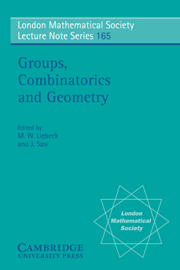Book contents
- Frontmatter
- Contents
- Authors' Addresses
- Introduction
- Part 1 Sporadic groups
- 1 Uniqueness of sporadic groups
- 2 The study of J4 via the theory of uniqueness systems
- 3 Y555 and all that
- 4 Hyperbolic reflections for the Bimonster and 3Fi24
- 5 A geometric characterization of the Monster
- 6 Constructing the Monster
- Part 2 Moonshine
- Part 3 Local and geometric methods in group theory
- Part 4 Geometries and related groups
- Part 5 Finite and algebraic groups of Lie type
- Part 6 Finite permutation groups
- Part 7 Further aspects of simple groups
- Part 8 Related topics
4 - Hyperbolic reflections for the Bimonster and 3Fi24
Published online by Cambridge University Press: 07 September 2010
- Frontmatter
- Contents
- Authors' Addresses
- Introduction
- Part 1 Sporadic groups
- 1 Uniqueness of sporadic groups
- 2 The study of J4 via the theory of uniqueness systems
- 3 Y555 and all that
- 4 Hyperbolic reflections for the Bimonster and 3Fi24
- 5 A geometric characterization of the Monster
- 6 Constructing the Monster
- Part 2 Moonshine
- Part 3 Local and geometric methods in group theory
- Part 4 Geometries and related groups
- Part 5 Finite and algebraic groups of Lie type
- Part 6 Finite permutation groups
- Part 7 Further aspects of simple groups
- Part 8 Related topics
Summary
Introduction
In, the “bimonster” (the wreathed square of the Fischer-Griess monster group) was studied in terms of its representation as a quotient of a certain infinite Coxeter group. Here we shall use the representation of this Coxeter group as a hyperbolic reflection group to investigate both the bimonster and its subgroup 3Fi24.
Throughout the paper, we shall use the notation of for group structures. In section 1, we give a simple axiomatic definition of a group G, and deduce that G is generated by 16 involutions that satisfy the Coxeter relations of Figure 1. This allows us to represent them in Section 2 by reflections in certain vectors of a hyperbolic space (that is, a space with a Lorentzian metric).
This notation makes it easy to perform calculations with these elements. In Section 2, we shall find some relations that must hold in G, but are not consequences of the Coxeter relations, and will use these to establish many identities in G, which we express in terms of alias groups.
Our section 4 contains a short proof of the 26 node theorem of.
The remainder of the paper is devoted to the subgroup Y552 of G, which we shall show has the structure 3Fi24. By way of introduction, Section 5 is used to show that the smaller group Y551 has structure, by completely enumerating its root vectors. In Section 6, we describe the root vectors for 3Fi24, and compute the corresponding alias groups.
A certain element ωis defined in Section 7, and shown to generate a normal subgroup of order 3 in Y552.
- Type
- Chapter
- Information
- Groups, Combinatorics and Geometry , pp. 24 - 45Publisher: Cambridge University PressPrint publication year: 1992
- 7
- Cited by

